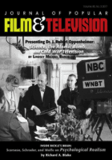
JOURNAL OF POPULAR FILM AND TELEVISION
Scope & Guideline
Transforming Perspectives Through Film and Television Analysis.
Introduction
Aims and Scopes
- Cultural Analysis of Media Texts:
The journal focuses on examining how films and television shows reflect, shape, and challenge cultural norms and values. It encourages interdisciplinary approaches that integrate cultural studies, media studies, and critical theory. - Representation and Identity:
A significant aim is to explore issues of representation, particularly concerning race, gender, sexuality, and class. The journal highlights how popular media constructs identities and how these representations influence societal perceptions. - Historical Contextualization:
The journal emphasizes the importance of historical context in understanding film and television. It publishes works that analyze media texts in relation to their historical, political, and social environments. - Genre Studies and Innovation:
Research on genre conventions, evolution, and the impact of technological advancements in film and television is a core area. The journal encourages studies that explore genre blending and the emergence of new forms. - The Impact of New Media:
With the rise of streaming services and digital platforms, the journal investigates how these changes affect audience engagement and the production of popular media.
Trending and Emerging
- Dark Television and Complex Narratives:
Recent publications emphasize the engagement of audiences with darker themes in television series, such as the analysis of 'Game of Thrones.' This trend indicates an increasing interest in how complex narratives reflect societal anxieties. - Transcultural and Global Perspectives:
The journal is seeing a rise in studies that examine transcultural exchanges in media, as evidenced by analyses of shows like 'Man Like Mobeen.' This reflects a growing recognition of the interconnectedness of global media landscapes. - Neurodiversity and Representation:
There is an emerging focus on neurodiversity within popular media, showcasing how characters with diverse cognitive experiences are represented. This trend aligns with broader discussions about inclusivity and representation. - Women in Genre and Horror:
The exploration of women's roles in traditionally male-dominated genres, particularly horror, is gaining traction. This reflects a broader cultural movement towards recognizing female contributions and perspectives in media. - Impact of Streaming Services on Storytelling:
The rise of streaming platforms and their impact on narrative structures and audience engagement is a key emerging theme. The journal is increasingly publishing works that analyze how streaming changes the landscape of storytelling.
Declining or Waning
- Traditional Film Criticism:
There has been a noticeable decrease in papers focused solely on traditional film criticism, which often emphasizes aesthetic and technical analysis. This shift indicates a growing preference for cultural and social analyses over formal critique. - Classic Cinema Studies:
Research centered on classic films from earlier decades is less prevalent now. The journal appears to be moving towards more contemporary analyses, reflecting the current media landscape's focus on modern narratives and storytelling. - Hollywood-centric Perspectives:
Papers exclusively focusing on Hollywood as the primary context for analysis are declining. This trend suggests a broader interest in global cinema and diverse narratives that extend beyond traditional Hollywood frameworks. - Proliferation of Genre Studies:
While genre studies remain important, there is a reduction in studies that treat genres as static categories. The journal is increasingly favoring dynamic analyses that consider genre hybridity and the fluidity of genre boundaries.
Similar Journals

Transnational Screens
Bridging Cultures Through the Lens of Contemporary MediaTransnational Screens is a premier academic journal published by Taylor & Francis Ltd, focusing on the dynamic intersections of visual arts, performing arts, and communication in a globalized context. Since its inception, the journal has garnered significant recognition, featuring in the Q1 category for Visual Arts and Performing Arts and Q3 for Communication as of 2023, reflecting its influential contributions to these fields. With a Scopus ranking placing it in the 78th percentile in Visual Arts and Performing Arts, this journal serves as a vital platform for researchers, professionals, and students aiming to explore the implications of transnational narratives in contemporary media and artistic practices. The journal is accessible to a diverse readership and promotes open dialogue through its commitment to publishing innovative and interdisciplinary research from 2020 to 2024. As a key resource for understanding the complexities of transnational screens, it invites submissions that push the boundaries of traditional scholarship and engage with pressing global issues through the lens of the visual and performing arts.

MILLENNIUM FILM JOURNAL
Connecting Scholars and Practitioners in Film Exploration.MILLENNIUM FILM JOURNAL, published by MILLENNIUM FILM WORKSHOP INC, stands as a pivotal platform for exploration and discourse within the realm of film studies. With its ISSN 1064-5586, the journal has been noteworthy in delineating the complexities of visual arts and performing arts, contributing significantly to academic scholarship between the years 2009 to 2016, and in 2018. Though its coverage has been discontinued in Scopus, the journal has attained a respectable position within its category, ranking #320 out of 502 in the Arts and Humanities field. Researchers, professionals, and students alike are invited to engage with interdisciplinary discussions that illuminate the cultural and theoretical dimensions of cinema. While currently not offering open access options, the journal continues to serve as a vital resource for those deeply invested in the study of film, making it a respected voice in visual arts and performance research.
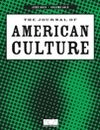
JOURNAL OF AMERICAN CULTURE
Engaging with the Vibrancy of American LifeJOURNAL OF AMERICAN CULTURE is a distinguished academic journal published by Wiley, focusing on the rich tapestry of American culture through various lenses including history, literature, visual arts, and cultural studies. Established in 1996 and continuing its scholarly contributions through 2024, the journal serves as a vital platform for researchers, professionals, and students to disseminate their work and engage with critical discussions surrounding American cultural narratives. With an impressive impact reflected in its 2023 quartile rankings — Q2 in Literature and Literary Theory and Q3 in Cultural Studies, History, and Visual Arts and Performing Arts — the journal enhances scholarly dialogue across diverse disciplines. Although it does not offer Open Access options, its rigorous peer-review process ensures high-quality research dissemination. It is a go-to resource for those aiming to explore the evolving dynamics of American culture within a global context.

Studies in Russian and Soviet Cinema
Cultivating Insights into Cinematic Practices and CulturesStudies in Russian and Soviet Cinema, published by Routledge Journals, Taylor & Francis Ltd, provides a critical forum for the exploration and analysis of cinematic practices, histories, and cultures from the Russian and Soviet eras. With its ISSN 1750-3132 and E-ISSN 1750-3140, this journal operates under the editorial guidance of leading scholars in the field, making significant contributions to the Visual Arts and Performing Arts and Communication categories, where it is ranked in the upper quartiles of its peer group. The journal spans a rich period of study, converging insights from 2006 to 2024, thereby allowing for an in-depth understanding of the evolution and impact of cinema in societal narratives. Researchers and enthusiasts alike will appreciate its dedication to illuminating the often-neglected cinematic treasures of Russia and the Soviet Union, promoting scholarly discourse through its rigorous analyses and diverse range of articles. This journal serves as an essential resource for anyone interested in the intersections of film, culture, and history.

FILM QUARTERLY
Advancing Film Theory and CritiqueFilm Quarterly, published by University of California Press, stands as a leading academic journal in the field of visual arts and performing arts, boasting a prestigious Q1 ranking in the 2023 category quartiles. Since its inception in 1969, this quarterly publication has made significant contributions to the study and critique of cinema, attracting attention for its insightful articles, cutting-edge research, and comprehensive reviews that appeal to scholars, practitioners, and students alike. With an ISSN of 0015-1386 and an E-ISSN of 1533-8630, it serves as an essential resource for those seeking to enhance their understanding of film theory, history, and analysis. Although not open access, its articles are critical for researchers navigating the complex landscape of contemporary and historical film studies, underscoring its vital role in advancing scholarship within the discipline.
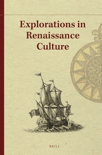
Explorations in Renaissance Culture
Unlocking the Secrets of Renaissance InnovationExplorations in Renaissance Culture, published by BRILL, is a pivotal academic journal that delves into the multifaceted aspects of Renaissance studies, encompassing Cultural Studies, History, Literature and Literary Theory, Music, Philosophy, and the Visual Arts. Established in 1976 and operating without an open access model, the journal has evolved as a critical platform for scholars and enthusiasts alike, providing rigorous analysis and innovative perspectives on the cultural currents of the Renaissance era. With an ISSN of 0098-2474 and an E-ISSN of 2352-6963, it has garnered a respectable standing among academic peers, evidenced by its quartile ranking in the Q4 category across multiple fields as of 2023 and its Scopus rankings, which acknowledge its role within the broader arts and humanities disciplines. Based in the Netherlands, the journal plays a vital role in fostering scholarly dialogue and advancing research, making it an essential resource for researchers, professionals, and students committed to expanding their understanding of this transformative period in history.
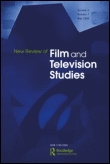
New Review of Film and Television Studies
Advancing Critical Discourse in Visual StorytellingNew Review of Film and Television Studies, published by Routledge Journals, Taylor & Francis Ltd, stands as a vital platform for scholars and practitioners engaged in the dynamic fields of film and television studies within the United Kingdom. This journal, which has been in circulation since 2010 and will continue through 2024, provides a rigorous academic forum for contemporary research, critical analysis, and innovative discourse surrounding visual storytelling. With an impressive Scopus rank placing it in the 66th percentile for Visual Arts and Performing Arts, and a respectable Q2 categorization, the journal fosters an interdisciplinary approach, bridging communication and cultural studies. While the journal does not currently operate under an open access model, it remains an invaluable resource for researchers, students, and professionals aiming to understand and influence the evolving landscape of film and television in our digital age. As it navigates the intersection of media and society, New Review of Film and Television Studies is essential reading for those looking to advance their knowledge and contribute to the ongoing scholarly conversation.

ART HISTORY
Unveiling the Complexities of Visual and Performing ArtsART HISTORY is a prestigious journal published by Wiley, focusing on the dynamic and diverse field of visual arts and performing arts since its inception in 1978. With an ISSN of 0141-6790 and an E-ISSN of 1467-8365, the journal has established itself as a significant resource for researchers, professionals, and students interested in exploring the complexities of art across various epochs and cultures. Currently ranked in the Q3 category within the Visual Arts and Performing Arts sector and positioned at #132 out of 667 in Scopus rankings—representing the top 80th percentile—ART HISTORY delivers insightful scholarship that contributes to the understanding and appreciation of art history. Although it does not offer open access, the journal remains committed to publishing high-quality, peer-reviewed articles that delve into critical artistic practices, theories, and aesthetics. The journal's location in the United Kingdom further enhances its international reach and influence, making it a vital platform for advancing discourse in the arts.
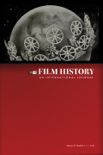
Film History
Charting the dynamic relationship between film and society.Film History, published by Indiana University Press, is a premier academic journal that delves into the evolving landscape of cinema, illuminating the intricate interplay between historical narratives and film culture. With ISSN 0892-2160, and E-ISSN 1553-3905, this journal has established itself as a crucial resource for researchers, professionals, and students in the fields of history and visual arts. Recognized in the Q2 category for both History and Visual Arts and Performing Arts as of 2023, it boasts impressive Scopus rankings, securing #152 out of 667 in Visual Arts and Performing Arts, and #524 out of 1760 in History, placing it in the top 30th percentile. Although it does not currently offer open access options, the journal provides a wealth of scholarly articles that critically engage with film as a historical text, fostering a deeper understanding of its role in shaping societal narratives. Since its inception in 1987, Film History has been at the forefront of academic discourse, making it an invaluable resource for those seeking to explore the rich tapestry of cinematic history.
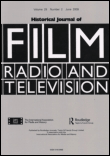
HISTORICAL JOURNAL OF FILM RADIO AND TELEVISION
Advancing Scholarship in Film, Radio, and Television StudiesHISTORICAL JOURNAL OF FILM RADIO AND TELEVISION, published by Routledge Journals, Taylor & Francis Ltd, is a leading academic publication that explores the intricate narratives of film, radio, and television throughout history. With an ISSN of 0143-9685 and an E-ISSN of 1465-3451, this journal has established itself as a vital resource for researchers and professionals within the fields of communication, history, and the visual arts, reflecting its commitment to rigorous scholarship since its inception in 1981. The journal occupies a reputable position in the academic landscape, recently categorized as Q4 in Communication and History, and Q3 in Visual Arts and Performing Arts, indicating its relevance in these fields. Despite the absence of Open Access options, the publication remains accessible to institutions and individuals eager to engage with critical analyses and historical perspectives on visual media. With its broad scope and historical emphasis, the HISTORICAL JOURNAL OF FILM RADIO AND TELEVISION is crucial for understanding the evolution of media and its impact on culture, making it an essential read for scholars and practitioners alike.